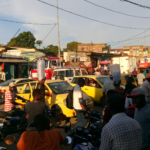Members of the Science and Security Board of the Bulletin of the Atomic Scientists win Leo Szilard Award
By Bulletin Staff | October 11, 2013
The Bulletin of the Atomic Scientists: It is 5 Minutes to Midnight
CHICAGO – October 4, 2013 – Two members of the Bulletin of the Atomic Scientists’ distinguished Science and Security Board have received the 2014 Leo Szilard Award. Dr. M.V Ramana, physicist and lecturer at Princeton University’s Program on Science and Global Security; and Ramamurti Rajaraman, emeritus professor of physics at Jawaharlal Nehru University and a co-chair of the International Panel on Fissile Materials, share the award from the American Physical Society. The Leo Szilard Lectureship Award recognizes “outstanding accomplishments by physicists in promoting the use of physics for the benefit of society in such areas as the environment, arms control, and science policy.” Both Ramana and Rajaraman have served on the Science and Security Board of the Bulletin since 2009.
"We are thrilled that the policy research of Ramana and Rajaraman is being recognized with this award," said Bulletin executive director Kennette Benedict. "Their respective contributions to global security, by examining the military and civilian uses of nuclear energy in South Asia, are critical to developing sound nuclear policy in the region. Their expertise has shaped debates in India by challenging conventional wisdom about the role of nuclear energy in South Asia with special concern about prospects for non-proliferation and nuclear disarmament."
“The Leo Szilard Award was established to recognize the application of physics to solving social problems around the world,” said Robert Rosner, co-chair of the Bulletin’s Science and Security Board. “With this announcement, the American Physical Society recognizes the immense threat nuclear weapons still pose, and the work of two outstanding scientists toward making the world a safer place for all humanity.”
The Science and Security Board of the Bulletin meets twice per year to discuss the state of world affairs and threats to humanity, and to discuss the setting of the minute hand of the Bulletin’s Doomsday Clock. This year, in association with their November meeting, the Bulletin’s Science and Security Board is convening a day-long conference on November 14, “Communicating Catastrophe,” in collaboration with the Smithsonian Hirshhorn Museum and their exhibition “Damage Control: Art and Destruction Since 1950.”
ABOUT THE BULLETIN OF ATOMIC SCIENTISTS
Founded in 1945 by University of Chicago scientists who had helped develop the first atomic weapons in the Manhattan Project, the Bulletin of the Atomic Scientists subsequently created the Doomsday Clock in 1947 using the imagery of apocalypse (midnight) and the contemporary idiom of nuclear explosion (countdown to zero), to convey threats to humanity and the planet. The decision to move the minute hand of the Doomsday Clock is made by the Bulletin's Science and Security Board in consultation with the Governing Board and the Board of Sponsors, which includes 18 Nobel Laureates. The Clock has become a universally recognized indicator of the world's vulnerability to catastrophe from nuclear weapons, climate change, and emerging technologies in the life sciences.
CONTACT: Janice Sinclaire, 707.481.9372, or [email protected]
Together, we make the world safer.
The Bulletin elevates expert voices above the noise. But as an independent nonprofit organization, our operations depend on the support of readers like you. Help us continue to deliver quality journalism that holds leaders accountable. Your support of our work at any level is important. In return, we promise our coverage will be understandable, influential, vigilant, solution-oriented, and fair-minded. Together we can make a difference.














